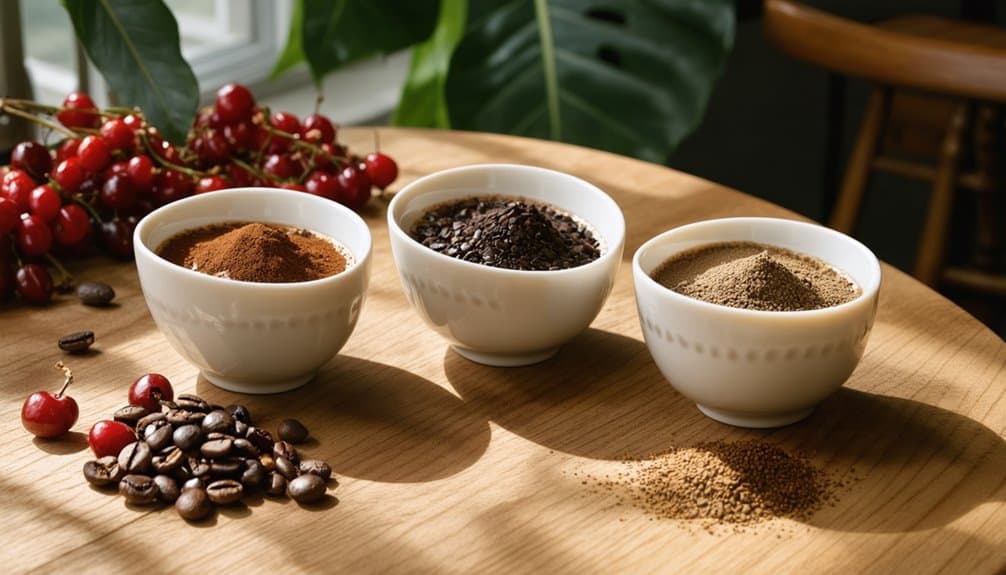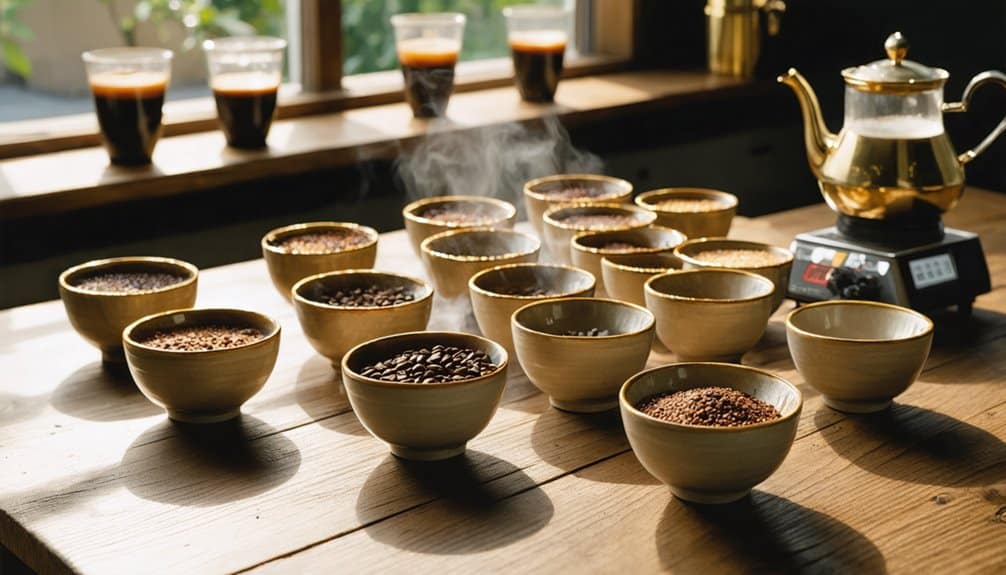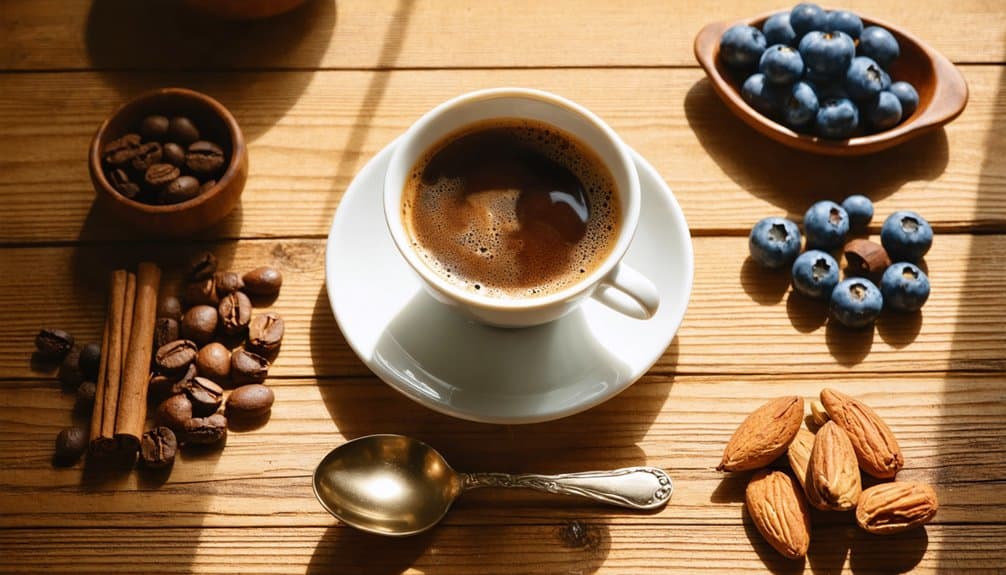You’ll uncover coffee’s hidden flavors through systematic tasting techniques that engage all your senses.
Start by evaluating the aroma, then employ proper slurping methods to aerate the coffee and intensify flavor compounds.
Use the Coffee Flavor Wheel to identify primary notes like chocolate and nuts, then progress to secondary characteristics such as fruity, floral, or spicy elements.
Clean equipment, precise measurements, and detailed tasting notes will strengthen your palate development.
From Ethiopian bright fruit notes to Indonesian earthy profiles, each origin offers distinct characteristics waiting to be revealed through proper cupping methods.
Key Takeaways
- Practice the slurping technique to aerate coffee, which enhances flavor compounds and helps identify subtle taste variations.
- Use the Coffee Flavor Wheel by starting at the center with broad categories and working outward to specific flavor notes.
- Compare multiple coffee samples side-by-side while maintaining detailed tasting notes to track and identify flavor differences.
- Cleanse your palate between tastings with water or mild crackers to ensure accurate flavor identification.
- Begin with identifying primary flavors like chocolate and nuts before progressing to secondary notes and subtle undertones.
The Basics of Coffee Tasting

Releasing the complex world of coffee tasting begins with mastering the five fundamental sensory steps.
You’ll start by deeply inhaling the coffee’s aroma from the grounds, which provides essential hints about the flavors you’re about to experience.
Next, you’ll take a measured sip, allowing the coffee to coat your palate and register initial taste sensations.
The significant slurping step follows, where you’ll aerate the coffee across your taste buds to intensify the flavor compounds.
The ideal water temperature of 200°F ensures optimal extraction during the brewing process.
Proper espresso extraction pressure of 9 bars is essential for achieving the most authentic and rich flavors in espresso-based drinks.
As you’re developing your tasting technique, you’ll assess the coffee’s body and texture, noting whether it feels light and delicate or rich and syrupy.
Ultimately, you’ll identify and articulate the primary flavor notes, which might include fruity, floral, nutty, sweet, or spicy characteristics that define your cup’s unique profile.
Understanding Coffee Flavor Profiles
You’ll uncover that beans from different global regions express distinct flavor characteristics, with Ethiopian coffees often showcasing bright, fruity notes while Indonesian varieties tend toward earthy, full-bodied profiles.
Your coffee’s roast level dramatically transforms these inherent flavors, as light roasts highlight the bean’s original characteristics while dark roasts intensify caramelization and bitterness.
The brewing method you choose further shapes these flavor expressions, with immersion methods like French press emphasizing body and oils, while pour-over techniques accentuate clarity and bright notes.
Understanding the complex flavor profiles requires thoughtful consideration of how different beans interact when blended together.
Geographic Origin Matters
When exploring the world of coffee, geographic origin stands as one of the most crucial factors in determining a bean’s flavor profile.
You’ll uncover that each continent offers distinct characteristics: African beans, particularly from Ethiopia and Kenya, deliver bright, fruity notes with high acidity, while South American varieties from Brazil and Colombia present balanced, chocolatey profiles with medium acidity.
Central American beans showcase complex combinations of chocolate, nuts, and spices. Growing at elevations of 1700-2200 feet contributes to the distinct sweetness found in African coffee beans.
Asian coffees, especially from Indonesia and Vietnam, offer earthy, spicy notes with lower acidity and fuller bodies.
You’ll find that Pacific regions, like Papua New Guinea, contribute unique profiles featuring bright acidity with tropical fruit undertones.
Understanding these regional differences helps you identify and appreciate the intricate flavors in your cup, from floral Ethiopian notes to caramel-rich Brazilian beans.
Roast Level Impact
A coffee bean’s voyage through diverse roast levels transforms its inherent flavors into distinct profiles that shape your tasting experience.
As you investigate these profiles, you’ll uncover how roasting time and temperature create a spectrum of sensory possibilities.
The Maillard reaction process drives these dramatic flavor changes during roasting, creating complex chemical transformations in the beans.
| Roast Level | Sensory Characteristics |
|---|---|
| Light | Bright acidity, citrus notes, floral aromatics |
| Medium | Balanced sweetness, nutty undertones, caramel hints |
| Medium-Dark | Rich body, chocolate notes, muted acidity |
| Dark | Bold intensity, smoky essence, bittersweet finish |
| Extra Dark | Deep char, intense body, pronounced bitterness |
You’ll notice how lighter roasts preserve the bean’s natural acidity and fruity notes, while darker roasts develop more robust, bittersweet characteristics.
Understanding these transformations helps you identify the subtle nuances in your cup and select roasts that align with your palate preferences.
Brewing Method Expressions
Each brewing method reveals distinct flavor profiles from your coffee beans, creating unique sensory experiences through varying extraction processes.
Espresso’s high pressure intensifies flavors, delivering concentrated richness, while pour-over brewing highlights bright, aromatic notes through controlled extraction.
Medium roasts typically deliver balanced flavor compounds that work well across multiple brewing methods.
Your choice of brewing method can emphasize specific flavor characteristics:
- French press amplifies body and texture, letting oils create a full-bodied, robust cup with pronounced earthiness
- Pour-over brings out delicate floral notes and bright acidity, perfect for light roasts
- Aeropress offers versatility, allowing you to fine-tune extraction for balanced, nuanced results
Understanding these expressions helps you match brewing methods to your desired flavor profile.
A fruity Ethiopian bean might shine through pour-over, while a chocolatey Brazilian could express beautifully through French press or espresso.
Essential Coffee Tasting Equipment

Professional coffee tasting requires specific tools and equipment to evaluate beans effectively and consistently.
You’ll need cupping bowls with 160-200ml capacity to hold your samples, precise scales for accurate measurements, and a grinder that delivers coarse, sea salt-sized particles.
Deep-bowl spoons enable proper slurping technique, while tall spit cups prevent splash back during evaluation.
Twenty grams of coffee per sample provides optimal tasting portions.
For advanced cupping sessions, you’ll want to incorporate precision instruments like a colorimeter to assess bean color and a refractometer to measure dissolved solids.
Your hot water source should be neither softened nor distilled, and you’ll need to let it rest 1-3 minutes off boil.
Organize your workspace with cupping table trays, bean trays, and keep clean rags handy for drying spoons between tastings.
Developing Your Coffee Palate
Developing a refined coffee palate depends on cultivating your sensory awareness through systematic tasting practices.
You’ll need to engage multiple senses, starting with smell evaluation both before and after brewing, followed by intentional sipping and slurping techniques to aerate the coffee across your palate.
Maintaining a detailed tasting journal helps document and track your sensory observations over time.
To build your flavor recognition skills, focus on these fundamental elements:
- Primary taste components: sweet, sour, salty, and bitter notes
- Body characteristics: weight, texture, and mouthfeel
- Aromatic profiles: fruity, floral, nutty, or earthy undertones
Practice comparative tasting with different beans and brewing methods, keeping detailed notes of your observations.
Remember to cleanse your palate between tastings with water or mild crackers. You’ll gradually develop the ability to detect subtle nuances and complex flavor interactions in every cup.
Using an espresso machine with low-pressure pre-infusion helps extract balanced flavors for more accurate taste evaluation.
Using the Coffee Flavor Wheel

You’ll find the coffee flavor wheel organized into three primary rings, with broad categories like “fruity” and “floral” in the center, expanding outward to more specific descriptors such as “berry” or “jasmine.”
As you taste your coffee, you can engage with increasingly nuanced flavor notes by starting at the center and working your way to the outer rings where you’ll uncover precise descriptors like “blackberry” or “orange blossom.”
To develop proficiency with the wheel, you should practice identifying and connecting flavors systematically, using reference samples when possible to calibrate your sensory perception to specific attributes.
The wheel supports both casual tastings and professional cupping sessions, making it a versatile tool for all coffee enthusiasts.
Understanding Basic Categories
When exploring the intricate world of coffee tasting, the Coffee Flavor Wheel serves as an indispensable tool for identifying and describing the complex sensory characteristics in your cup.
As you develop your palate, you’ll uncover that coffee flavors fall into distinct primary categories, each branching into more nuanced subcategories.
Professional tasters and buyers regularly use this standardized system to ensure clear communication about flavor profiles.
To effectively use the wheel, start at its center and work outward, identifying:
- Basic taste elements like sweet, sour, and bitter
- Mid-level descriptors such as fruity, floral, or nutty
- Specific flavor notes like jasmine, berries, or hazelnut
You’ll find that certain categories frequently appear in coffee evaluation, including the sweet notes of caramel and vanilla, bright citrus characteristics, and earthy undertones reminiscent of tobacco or leather.
With practice, you’ll detect these subtle flavor variations with increasing precision.
Reading Complex Flavor Notes
Mastering the Coffee Taster’s Flavor Wheel requires a methodical approach to identifying and articulating complex flavor notes.
You’ll start at the center with broad categories, then work your way outward to pinpoint specific descriptors, ranging from fruity notes like citrus or berry to earthy qualities like mushroom or wet soil.
When you’re evaluating your coffee, remember to assess both aroma and taste systematically.
Many tasters detect different aromas when grinding versus brewing coffee. Slurp the coffee to aerate it across your palate, noting how flavors develop and change.
You’ll want to identify primary tastes initially, then drill down to specific attributes using the wheel’s hierarchical structure.
Compare what you’re experiencing to the wheel’s reference materials and intensity scores (1-15).
As you practice, you’ll develop the ability to recognize and articulate the over 1,000 chemical compounds that create coffee’s complex flavor profiles.
Practicing Wheel Navigation
The Coffee Taster’s Flavor Wheel serves as your vital navigational tool for precise flavor identification, starting from broad categories at its center and radiating outward to increasingly specific descriptors.
To navigate effectively, begin at the center and work your way out, letting your senses guide you through increasingly detailed attributes among the 110 possible descriptors.
Professional Q graders evaluate flavors on a 15-point intensity scale for maximum accuracy.
When you’re evaluating a coffee, follow these key steps:
- Start with deep inhalations to identify primary aromatics
- Take mindful sips, letting the coffee coat your palate
- Return to the wheel’s center for each new flavor revelation
You’ll find that colors help associate related attributes, while contrasting positions on the wheel indicate opposing characteristics.
Practice this systematic approach regularly, and you’ll develop a more refined ability to articulate complex flavor profiles.
Advanced Coffee Tasting Techniques
Professional coffee tasting demands a sophisticated understanding of sensory evaluation techniques and precise methodology.
You’ll need to master the art of proper slurping, which coats your palate and enables full flavor recognition.
Begin by grinding your beans to a coarse, sea salt consistency and striking the cupping bowl to release aromatic compounds.
Clean equipment thoroughly before each tasting session to prevent flavor contamination.
As you develop your expertise, you’ll identify primary flavor components like chocolate and nuts, while uncovering secondary notes of fruit, florals, and spices.
Pay careful attention to how different flavors present themselves: initial impressions, middle notes, and lingering aftertastes.
Practice comparing multiple coffees side-by-side to sharpen your ability to detect subtle variations.
Through balanced extraction and methodical tasting, you’ll learn to articulate complex flavor profiles and join the ranks of discriminating coffee professionals.
FAQs
Can Pregnancy Affect How Coffee Tastes?
You’ll notice dramatic changes in coffee’s taste during pregnancy, as hormonal shifts trigger dysgeusia, causing metallic or sour notes. Your perception may shift markedly, especially in your initial trimester.
Why Does Coffee Taste Different at Different Altitudes?
You’ll taste different flavor profiles because altitude affects bean development. Higher elevations create slower growth, concentrating sugars and acids, while producing more complex, vibrant notes with citrus and floral characteristics.
Does Drinking Coffee Affect Your Ability to Taste Wine?
Keep your eyes peeled – coffee can improve wine’s sweetness by altering your taste perception. You’ll notice this especially with wines, brandies, and whiskies, while vodka’s profile remains unchanged.
Why Does Coffee Taste Better in Ceramic Cups Than Paper Ones?
You’ll taste coffee’s true flavors in ceramic cups because they don’t absorb crucial oils or aromatic compounds like paper does, and ceramic’s excellent heat retention keeps your brew at ideal tasting temperature.
Can Medications Change How Coffee Tastes to You?
Your medications can considerably alter your coffee’s taste profile through direct receptor interactions, causing metallic notes, bitter undertones, or reduced sensitivity to coffee’s complex flavor compounds and aromatics.
The Bottom Line
You’ll find that mastering coffee tasting transforms your daily ritual from a simple caffeine fix into an intricate sensory expedition.
Whether you’re detecting bright citrus high notes or deep chocolate undertones, your trained palate now distinguishes subtle nuances that once went unnoticed.
Armed with your cupping spoon and flavor wheel, you’ve developed a technical understanding that bridges the gap between casual drinker and seasoned cupper.
